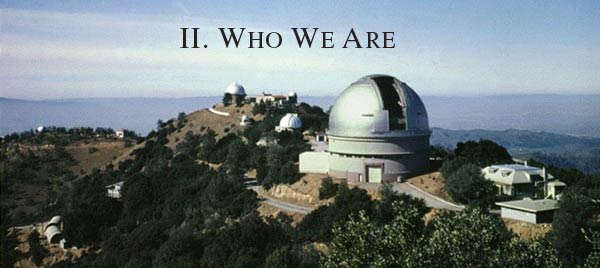


UNIVERSITY OF CALIFORNIA OBSERVATORIES / LICK OBSERVATORY









 | |
 | |
UNIVERSITY OF CALIFORNIA OBSERVATORIES / LICK OBSERVATORY | |
 | |
 | |
| Location and Users | |
| Lick Observatory, located on Mt. Hamilton 14 miles east of downtown San Jose, is an integral part of the University of California. Its telescopes are used by astronomers from campuses throughout the University of California, and their collaborators worldwide. We estimate that 15% of observational astronomers in the United States are institutionally affiliated with the University of California, and hence enjoy direct access to Mt. Hamilton's facilities. Lick is administered by University of California Observatories (UCO), headquartered at UC Santa Cruz. The UCO staff numbers approximately 160, including researchers, technicians, machinists, engineers, maintenance, and clerical workers, with about 25 resident on Mt. Hamilton. Fourteen of the staff are also professors in the Astronomy and Astrophysics Department of UC Santa Cruz. | |
 | |
| Longterm Leadership | |
| Lick Observatory is a major center of astronomical research, and has been since its inception in 1888. From the 1892 discovery of Jupiter's fifth moon (Galileo had discovered the first four nearly 300 years earlier), to numerous recent discoveries of planets around stars other than our sun; from the first laser-precision measurements of our moon's distance from Earth as part of the Apollo 11 mission, to the record for most distant object known in the universe (a quasar); from timing of pulsar rotation rates with millionth-of-a-second accuracy to the first indications of megastructure in the extra-galactic universe, Lick Observatory has consistently been at the forefront. | |
 | |
| Superb Instrumentation | |
| Lick excels in innovative development of the very best instruments to analyze light collected by telescopes. For example, Lick's largest (120-inch) telescope was recently featured in Time Magazine as the world's most prolific planet finder. This telescope incorporates an instrument whose unequaled precision has enabled discovery of more extra-solar planets than all other telescopes in the world combined. As another current example, scientists at Lawrence Livermore National Laboratory, in cooperation with Lick astronomers, have used the 120-inch Shane telescope to pioneer development of adaptive optics. This involves shining a laser beam high in the sky to create an artificial star, which is then used to correct for atmospheric turbulence, thus greatly improving quality of images. | |
 | |
| Site Quality | |
| Lick's scientific eminence is due both to the excellence of its staff and to superb observing conditions at Mt. Hamilton. Three conditions make for an excellent observing site: clear skies, steadiness of the atmosphere, and dark skies. Mt. Hamilton is blessed with both a large number of clear nights and a steady atmosphere. In 1888, when Lick Observatory was founded, the night sky was also dark. However, during the ensuing century, San Jose has grown from a modest agricultural town into the nation's eleventh largest metropolitan area. This growth has produced a corresponding increase in night sky brightness. | |
 | |
| State Investment | |
| The State of California has made a huge investment in Mt. Hamilton facilities. The capital value of the telescopes, domes, and other buildings is about $100 million. The State has recently provided $5.8 million for infrastructure upgrades. The operating budget of UCO/Lick Observatory is about $5 million a year. | |
 | |
| Public Involvement | |
| Over 30,000 visitors make the trip up the mountain to visit the Observatory each year. The Summer Concert Series and free Summer Visitor's Program play to sold-out audiences. We enjoy sharing our rich history and unique scientific achievements via daily tours. We also offer programs to science teachers which introduce Silicon Valley educators to hands-on techniques and practice of astronomical research and scientific method. College classes from throughout northern California come to Mt. Hamilton for evening tours and observing sessions with the 36-inch refractor. | |
 | |
| In Summary | |
| Lick Observatory remains at the forefront of astronomical research and technological development. | |
| Lick Observatory serves astronomers from throughout the University of California system, and their collaborators worldwide. | |
| Lick Observatory represents a major long-term investment by the State of California. | |
| Mt. Hamilton is an excellent site for astronomical observations. | |
| Lick Observatory provides a unique educational and cultural resource to residents of the Santa Clara Valley. | |